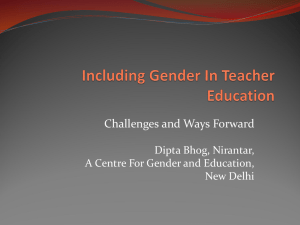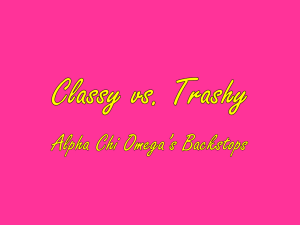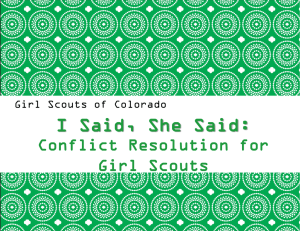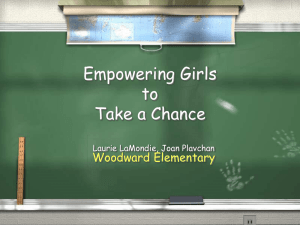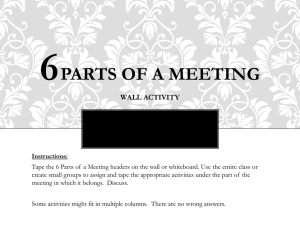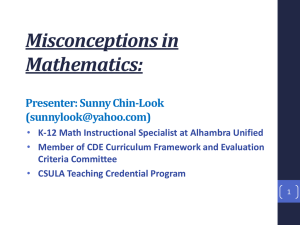Supplemental PowerPoint Presentation on Relational
advertisement
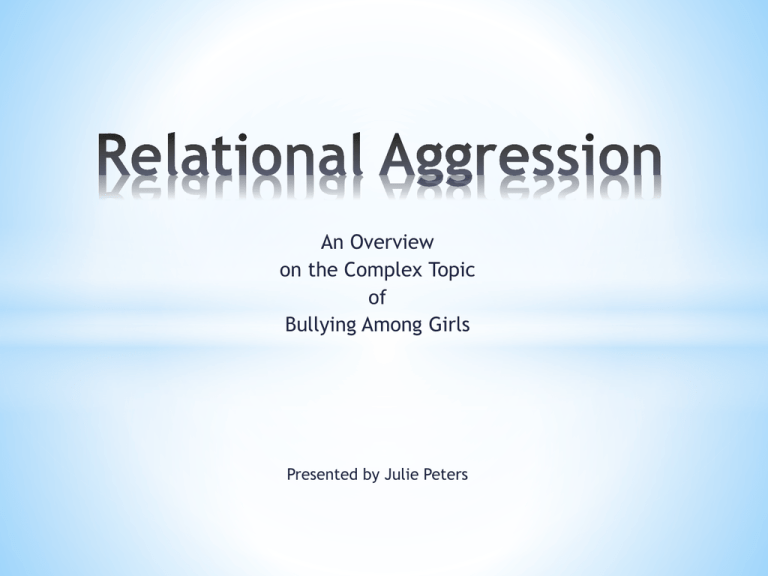
An Overview on the Complex Topic of Bullying Among Girls Presented by Julie Peters Types of Aggression * Direct Aggression (overt behavior typical of boys) * Indirect Aggression (covert behavior typical of girls) Social alienation Spreading rumors Manipulating the victim’s peer group * Note: boys are receiving more than two-thirds of support available for behavioral problems such as bullying Ringrose (p.509) 2 The Conflicts that Arise From Girls’ Friendships * Competition * Regulation of the Group * Protection of the Friendship 3 Friendship Differences Between Genders * Amount of friends * Closeness of friends * Focus of the interaction Besag (p.535) 4 Why do girls relate aggressively to their own best friends? * Conflicts of group often lead to “fighting back” or “withdrawing from the group”, which varies the status of victim (target girl), bystander(s), and aggressor. * Focus needs to be on why girls express their aggression indirectly. * Media/culture mixed messages: “Girls are made of sugar and spice and everything nice.” “Anything boys can do, girls can do better.” Besag(p.537); Ringrose (p. 511); Brown (191) 5 Recap of Information * Girls have the need to have close relationships with other girls. * Closeness often translates to opening up and sharing feelings, thoughts, fears, etc. * This leaves them feeling vulnerable and placing huge amounts of trust on the friend(s). * Girls are taught to be nice, which translates to not directly showing frustration, anger, jealousy, resentment, etc., so if they have any of these feelings, they must not directly express them. * Girls are taught to relinquish their Girl Card at the door when they enter male-dominated domains of society. * All of this can lead to competition, and ultimate betrayal. Brown (p.191) 6 What do girls compete over? * Academics * Social status * Boys * Class/socio-economic background * Note: it depends on their age group. Ringrose (p.512 and p.516) 7 Regulation of the Group: Adhering to Codes of Conduct * Group’s standards for popularity * Group’s standards for sexuality * Group’s standards for clothes/style/makeup * Group’s standards on anything you can imagine. * Note: group standards aren’t necessarily explicit. They also change as the group changes. Ringrose (p.515); Besag (p.537) 8 Protecting the Friendship Possible scenario: Girl #1 and Girl #2 are best friends (dyad). Girl #3 and Girl #4 are best friends (dyad). Girl #4 moves away. Girl #3 no longer has a best friend and becomes the “floater”. Besag(p.536) 9 The Bad Friendship So you’re gonna do my homework, right? Boyer(p.344-350) 10 I’m so glad the popular girl likes me! The “Developmental Trajectory of Girl-to-Girl Violence” 1. Initial blindness – “sets the stage for aggression” 2. Reputational conflict 3. Silent aggression 4. Physical aggression 5. A threat to victim support Boyer (p.347) 11 Reporting the Bullying Behavior * Often ineffective – viewed as “an 8th grade girl thing” * Sometimes worsens the situation – imposing a solution of “just be friends” * Defensiveness emerges – aggressor states “we got told we were bullying” Bright (p.93); Ringrose (p.517) 12 How to Help the Victim • • • • • • • “Pay attention to the formation and development of their friendship skills.” Be more aware of the “subtleties of both the verbal and body language” of girls interacting with one another. Eder’s Cycle of Popularity Model Alder and Alder’s Clique Formation hypothesis Schools need to adopt a Whole School Approach Educating girls about how dyad, triad, and floater relationships work Offer them safe avenues of addressing conflicts and feelings Besag (p.547 and p.536) 13 Summary * Bullying exists between girls, as well as boys; however, the bullying behavior typical of boys is receiving more attention. * Since there are distinct difference between the boy interactions and girl interactions, it stands to reason that programs addressing bullying behavior should be developed to address some of the issues that are unique to the interaction of girls. * Some of the ways of addressing the issues involve understanding the dynamics of girl friendships and offering effective methods for girls to express their feelings as conflict occurs. Ringrose (p.509) 14 Pros of Relational Aggression Awareness Programs * An increase in happy children. * A decrease in bullying behaviors. * Higher attendance in school. * Higher academic success. * Increased attention on the issue resulting in changes to how RA is viewed and handled by school personnel, community members, students, etc. 15 Cons of Relational Aggression Awareness Programs * Multicultural issues may not be adequately addressed due to the lack of research on multicultural differences in relational/social aggression. * A “one size fits all” approach used in some programs may be ineffective. The dynamics involved in relational aggression are complex! * Although relational aggression typically appears in female relationships, males sometimes become victims too. Programs geared primarily to females may overlook males in the equation or trivialize their experiences. * Time, Energy, Motivation, and Money: o These programs could cost money. o These programs require time from everyone involved. o If the program occurs after school, how much energy does everyone have to give to the topic? o If the program occurs during school, how motivated will teachers be about the program, considering they already have enough on their plate? 16 Works Cited Besag, Valerie. "Bullying Among Girls." School Psychology International 27.5 (2006): 535. Research Library, ProQuest. Web. 26 May. 2010. Besag, Valerie. Understanding Girls’ Friendships, Fights and Feuds: A Practical Approach to Girls’ Bullying. New York: Open University Press, 2006. Print. Boyer, Wanda. "Girl-to-Girl Violence: The Voice of the Victims." Childhood Education 84.6 (2008): 344-350. Research Library, ProQuest. Web. 26 May. 2010. Bright, Robin. "It's just a Grade 8 girl thing: Aggression in teenage girls." Gender and Education 17.1 (2005): 93. Research Library, ProQuest. Web. 26 May. 2010. Brown, Lyn Mikel. Girlfighting. New York: New York University Press, 2003. Print. French, Patricia. "Understanding girls' friendships, fights and feuds: a practical approach to girls' bullying." Gender and Education 19.5 (2007): 651. Research Library, ProQuest. Web. 26 May. 2010. Ringrose, Jessica. "'Just be friends': exposing the limits of educational bully discourses for understanding teen girls' heterosexualized friendships and conflicts." British Journal of Sociology of Education 29.5 (2008): 509. Research Library, ProQuest. Web. 26 May. 2010. Simmons, Rachel. Odd Girl Out. Orlando: Harcourt, 2002. Print. 17



